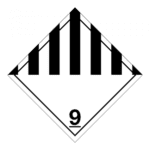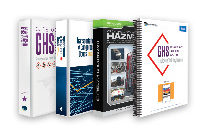This post was originally published in February 2021 and was reviewed in February 2023 to ensure accuracy.

A few months back, we posted a blog on the topic of UN3077 and UN3082 and how they can be classified as marine pollutants. But what exceptions exist in the regulations if your class 9 Environmentally Hazardous substance is classified as a marine pollutant? Let’s take a look at the various regulations and look at some of the exceptions you may encounter. Keep in mind these exceptions only apply to a substance that meets the criteria for a marine pollutant and does not exempt you from any other regulations. For example, if a marine pollutant is also a Class 3 Flammable Liquid, it may be subject to the marine pollutant exception; however, it would still need to be shipped regulated as a Class 3 Flammable Liquid.
49CFR
You will notice a common denominator in the wording of the 49CFR, IATA, and the IMDG code for the following exceptions. They all say “are not subject to any other provisions (regulations) of.” Essentially, what this means is, if you meet the criteria of the exemption, you don’t need to follow the regulations, with a few conditions that apply.
For example, the 49CFR 171.4 (c) (2) states that marine pollutants shipped in single or combination packaging containing a net quantity per single or inner packaging of 5 L or less for liquids or having a net mass of 5 kg or less for solids, are not subject to any other requirements of this subchapter provided the packaging meets the general requirements in 173.24 and 173.24a. As long as your packaging meets the requirements of 173.24 and 173.24A, and you follow the net quantity limits of the exemption, you can essentially ship this un-regulated.
Now keep in mind, this exception does not apply to marine pollutants that are a hazardous waste or a hazardous substances. In addition, as I mentioned before, in the case of marine pollutants also meeting the criteria for inclusion in another hazard class, all provisions of this subchapter relevant to any additional hazards continue to apply.
IATA and IMDG Code
Both the IATA and IMDG Code have similar exceptions to the one in the 49CFR. In IATA at Special Provision A197, it states that when these substances are transported in single or combination packaging containing a net quantity per single or inner packaging of 5 L or less for liquids or having a net weight per single or inner packaging of 5 kg or less for solids, they are not subject to any other provisions of these regulations provided the packaging meet the general provisions of 5.0.2.4.1, 5.0.2.6.1.1 and 5.0.2.8. In addition, the IMDG code at 2.10.2.7 pretty much says the same thing, with the exception of the packaging having to meet the general provisions sections 4.1.1.1, 4.1.1.2, and 4.1.1.4 to 4.1.1.8 of IMDG Code. More or less, the general packaging provisions that must be met by IMDG Code and IATA are similar in that both require the packaging to be of a high enough quality to withstand shocks and loading of normal transport, must be compatible with the hazardous substance, and allowing enough ullage (unfilled space) in the containers. In both cases, all provisions of the regulations relevant to any additional hazard classes would continue to apply.
What about TDGR?
In terms of Marine pollutants, TDGR does have some sections that mention specific exceptions regarding marine pollutants. For example, section 4.22 (2) states the marine pollutant mark is not required to be displayed when marine pollutants are on board a road vehicle or railway vehicle on a ro-ro ship or if it is contained in a small means of containment and are in a quantity that is less than or equal to 5 L for a liquid marine pollutant or 5 kg for a solid marine pollutant. The placard and UN number are not required to be displayed for substances identified as marine pollutants in subparagraph 2.43 (b) (ii) when the marine pollutant mark is not required to be displayed in accordance with subsection (2) mentioned above. In addition, the marking isn’t required on a large means of containment that is less than or equal to 500 kg and does not contain Class 1, Explosives, other than explosives included in Class 1.4, Class 5.2, Organic Peroxides, Class 6.1, Toxic Substances, or Class 7, Radioactive Materials.
Transport Canada also has a Special provision (SP99) in place if you are shipping UN 3077 or UN 3082 by ground that exempts you from the TDG regulations except Part 1 (General Provision) and Part 2 (Classifications) if you are shipping under 450 Liters or 450 KG on a road vehicle or railway vehicle. This applies as long as general packaging conditions are met that are mentioned in the special provision. If you don’t meet any of these exceptions mentioned in this blog and do need to ship your Marine Pollutant as a fully regulated dangerous good, we offer the required Environmentally Hazardous Substance Label and the class 9 hazard class labels among others. Feel free to call us at 1-888-442-9628 for more information.
We have all the products, services and training you need to ensure your staff is properly trained and informed.

|

Environmentally Hazardous Substance Label, |

|
Sources:
https://www.law.cornell.edu





